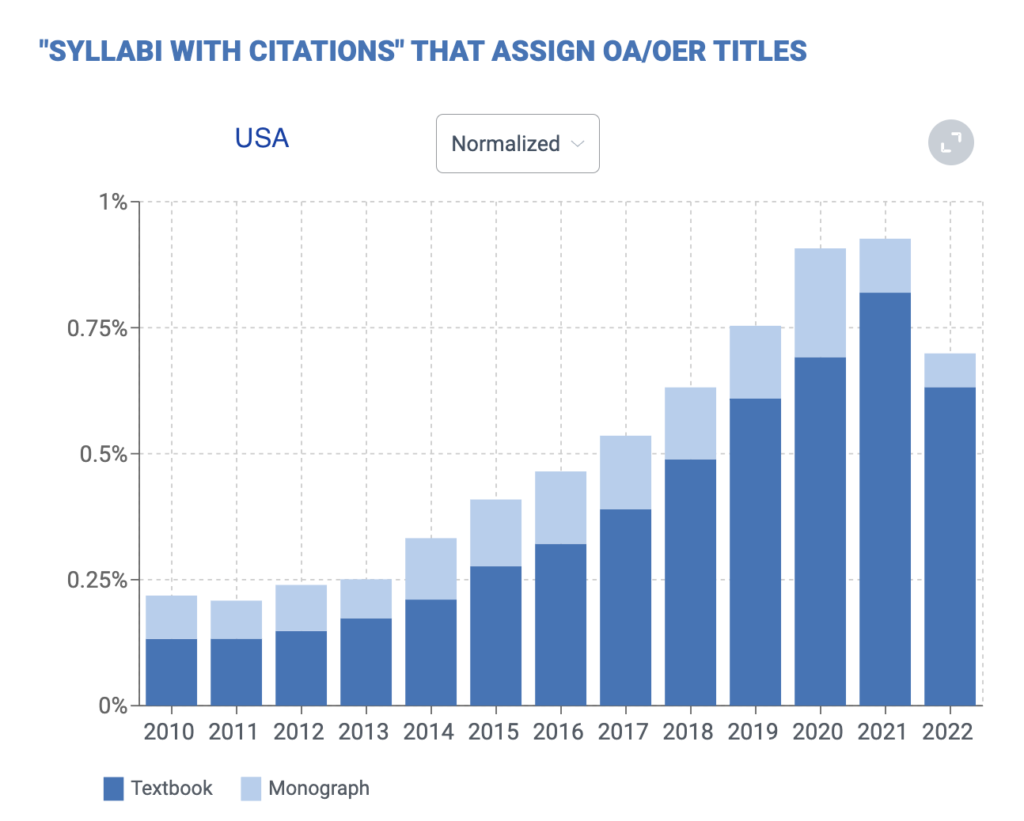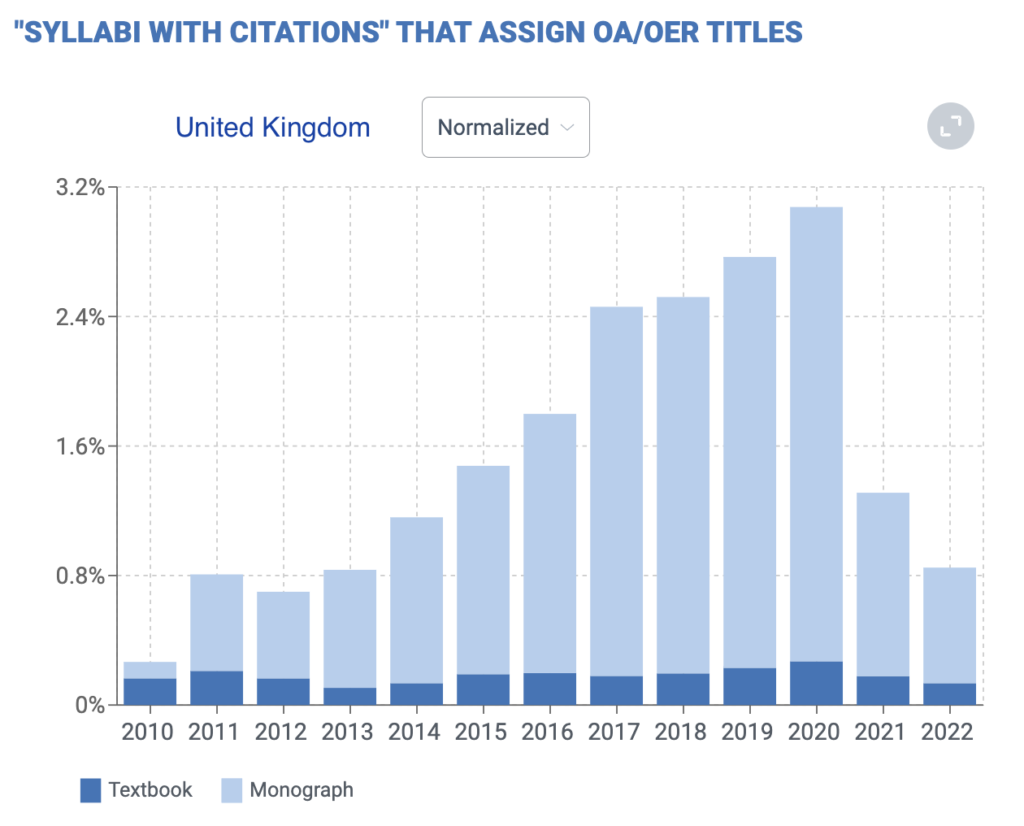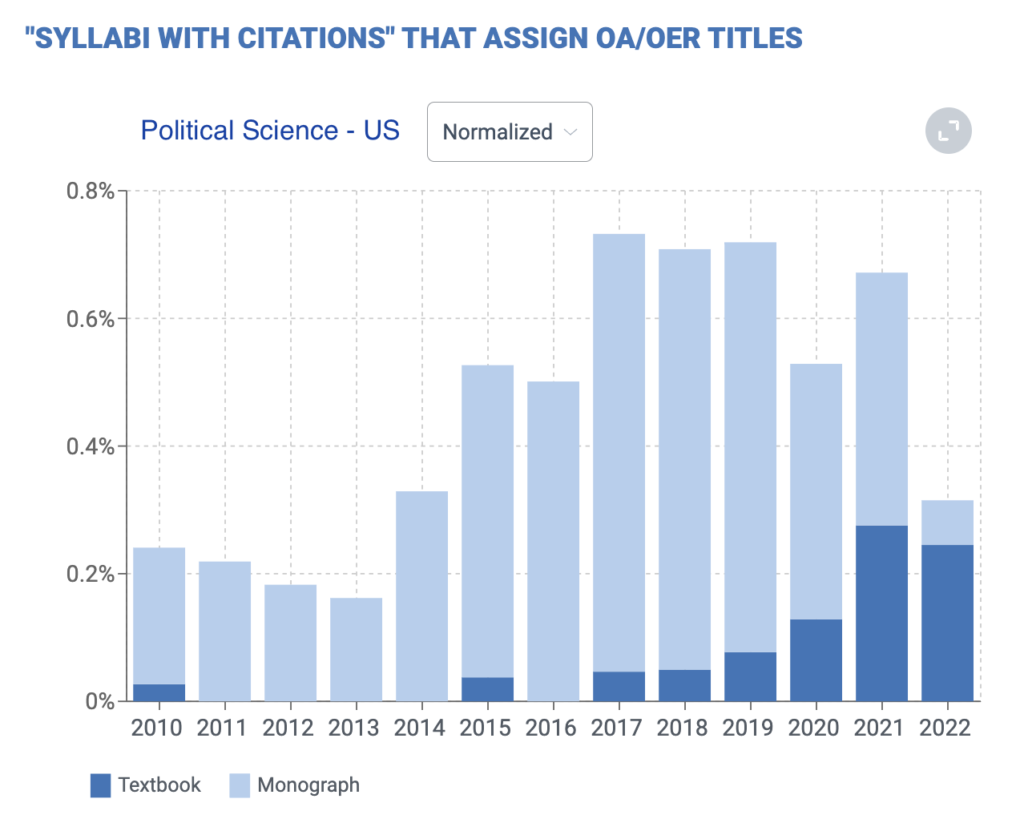There has been significant progress toward gender parity in many academic fields — and beyond it in some. The usual starting point for looking at this question in the US is the NSF’s "Survey of Earned Doctorates," which provides an annually-updated account of trends in PhD education. According to the most recent report from 2021, women make up almost 72% of psychology PhDs, 68% of health science PhDs, 53% in the biomedical sciences, and 50% in the social sciences. From there, percentages drop quickly: 33% in the physical sciences, 28% in math and statistics, 26% in engineering, and 25% in computer and information science. These percentages are not a measure of later employment in those fields — in fact the reality is probably somewhat worse due to "professional drop-off" among women in the STEM fields in which they are a minority. But it’s a place to start.
38 posts tagged with "opensyllabus"
View All TagsClosing the OER Information Loop: 2022 data

A few years ago we reported on the rates of growth in the adoption of ‘Open Educational Resource’ (OER) textbooks and ‘Open Access’ (OA) monographs. These are books published under Creative Commons licenses, which means that they can be used and circulated freely. In world of $200 commercial textbooks, OER textbooks, in particular, have become an important part of school and state efforts to reduce student costs.
But free has a few drawbacks. In markets for commercial textbooks (and most other goods), supply and demand are connected by the sale. Producers and consumers communicate through this information loop, and this relationship makes the market more or less efficient and — on the supply side — capable of adjusting.
The information loop for free digital books, on the other hand, isn’t closed. There is no sale or single point of access and titles are copied and circulate freely. It’s hard, accordingly, to know what the demand side of the OER and OA ecosystems looks like. And this lack of information becomes a problem for authors and publishers (the producers) and faculty and students (the consumers). Decisions to invest time and money by faculty, funders, libraries and others in creating new titles are made without strong insight into the demand for existing ones. Adoption decisions by faculty and staff are made without much visibility into the experience of other programs, which could provide models. Both sides of the equation involve risks, that those risks are hard to mitigate.
Open Syllabus can construct this demand side information from syllabi, and so partially close the information loop. The chart above continues the story we began to tell in 2021 — one of roughly 20% annual growth in OER adoption since the early days in 2013 and 2014. That’s fast growth, but from a very low baseline. In 2014, around .2% (1 in 500) syllabi used an OER textbook in the US. By 2021, that number was around .8% or 1 in 125. 2022 data shows a drop, but current year data can be uneven due to lag in our collecting practices. You can explore all of this in detail at the new Open Syllabus Analytics.
There is a lot of variety in adoption across countries, states, and fields. California is a national leader in OER adoption at nearly three times the national average. Texas lags the national average by about a third.


Canadian OER adoption looks very similar to the US but UK adoption is heavily skewed toward monographs, with very little traction for textbooks.


Math is the field with the strongest uptake whereas in other fields OER textbooks have only begun to be available.


Because textbook use is sticky, it can take a long time for new titles to accumulate momentum. The major OER math titles are around a decade old. The computer science titles a bit older. Social science titles and business titles have begun to emerge in significant numbers only in the last five years. Major commercial textbooks, in contrast, are often decades-old brands that become synonymous with their teaching subjects.
The question for the next years is whether that growth rate will be sustained. If it is, OER will begin to take a significant chunk of the overall textbook market. Open Syllabus demand metrics will chart that progress. And if we’re right, by charting it, accelerate it.
Hits of the 1990s
Hits of the 1990s
The Pudding published a fun and interesting visual exploration of which titles published in the 1990s have become part of the teaching canon in higher ed. The winner by a very large margin is Tim O’Brien’s The Things They Carried — a book of linked stories about the Vietnam War published in 1990. Woman Hollering Creek by Sandra Cisneros and Arundhati Roy’s The God of Small Things are #2 and #3. Harry Potter and the Sorcerer’s Stone is #4. Here is how those titles track over the past decade (this is from Open Syllabus Analytics — which you can test drive)
I have no special insight here, but a couple thoughts.
Independent of literary merit, successful new titles need a socially resonant theme. Middle-aged English professors in the 1990s were in their teens and twenties during the Vietnam War — a formative experience that probably contributed to The Things They Carried‘s classroom success. Can we test that with OS data? I think so. By the 2010s, the same faculty were retiring and, to an extent, carrying The Things They Carried with them — out of the classroom, slowly, partially, over the decade. Canonization is durable but not permanent, and the semester calendar forces zero-sum choices in the selection of texts.
Harry Potter is a different story — and not a shocker if one looks at the contexts in which it is assigned. The Harry Potter series is assigned primarily in children’s literature classes — not the American literature classes where you can find O’Brien and Cisneros, or the world and post-colonial literature classes that assign Roy. Children’s literature has a comparatively large footprint in OS data because it is a subfield of both English and Education. It also shows up in reading and literacy classes — again, both in the English and Education fields. The Sorcerer’s Stone is the representative text in these contexts. There’s not much classroom digging into the later books, though Prisoner of Azkaban is the distant #2.
Open Syllabus announces new support from the Arcadia Fund
Open Syllabus is pleased to announce the receipt of a $1,750,000, 2-year grant from the Arcadia Fund.
The Arcadia grant will enable Open Syllabus to continue to expand the boundaries of open education by developing new ways to understand and navigate the curriculum in higher education. The grant will support work on course transfer and learning outcomes, as well as a range of new tools designed to make OS data a more powerful resource for students, faculty, and lifelong learners.
Open Syllabus is a 501(c)3, US-based, non-profit organization that maps the curriculum in higher education and builds tools to support open education.
The Arcadia Fund is a UK charitable organization that supports work on endangered cultural heritage, endangered ecosystems, and open access.
So You Want to Write/Tweet Something About the The Communist Manifesto’s High Rank in the OS Dataset
The 4th place rank of The Communist Manifesto among all assigned titles in the OS collection (in the 2.5 dataset) has been written about and referenced frequently. Is this high ranking weird? Suspicious? What’s the story here?
To save ourselves some time responding on Twitter, we’ve decided to create a resource for authors and tweeters interested in engaging with this datapoint. The list of tips below doesn’t exhaust the topic of Marx’s role in the curriculum, but hopefully it will help you avoid some common misinterpretations of OS data related to Marx and the Manifesto. Let’s go!
Why does The Communist Manifesto rank 4th overall? Because it is frequently assigned in multiple fields. It’s 5th in History, 5th in Political Science, 5th in Sociology, 49th in Philosophy, and 153rd in English, 200th in Anthropology. Many titles achieve high rank in one or sometimes two fields. Very few have relevance in three or more. If you study 19th and 20th century history, politics, or social thought, you will at some point be assigned The Communist Manifesto–maybe more than once.
Let’s consider this talking point: “Marx is the most assigned economist in U.S. college classes.” Be careful with this one. Whether Marx is properly classified as an economist or not, he is not widely assigned in Economics, where the Manifesto ranks 192nd. Nor is his major work of economics, Capital, a top title. It ranks 378th overall and 182nd in Economics. For those who worry that Marx has displaced Adam Smith, he hasn’t. The Wealth of Nations is the top-ranked non-textbook title in Economics at #13. It also does well in History and Political Science.
In teaching, assigning something is not the same as endorsing it. This should go without saying, but the assumption that The Communist Manifesto is assigned primarily for the purposes of indoctrinating students is a frequent theme in these pieces. We don’t know all the contexts in which the Manifesto is assigned, but a look at the most common ‘co-assignments‘–i.e. the titles it is most frequently assigned with–strongly suggests that its primary teaching role is in classes that explore the canonical texts of Western political thought. What are the top co-assigned titles? Locke’s Second Treatise on Government; Hobbes’ Leviathan; Smith’s Wealth of Nations; Mill’s On Liberty; Weber’s Protestant Ethic and the Spirit of Capitalism, Machiavelli’s The Prince; Plato’s Republic. And so on.
The Manifesto has two other features that don’t come up much in these pieces but which probably significantly affect its rank. First, it’s a famous exercise in rhetoric rather than a treatise. Spend five minutes with it in comparison to any of the titles above and it’s clear why, even in translation, it has a role in literature and writing classes. Second–and probably more important–it’s short. At around 30 pages, it’s very easy to assign in a single class. Compare to the work of excerpting from the 1200 pages of Wealth of Nations, or the 650 pages of Leviathan, or the 450 of The Protestant Ethic and the classroom advantages are clear.
Comparative arguments: We urge caution. For those of you who, like the Marketwatch author linked above, want to compare the ubiquity of the Manifesto to the relative invisibility of the Bible in OS data, be aware that we identify works based on title/author combinations, and so struggle with titles that lack attributable authors. All the major religious texts and most of the foundational political documents are in the same boat. For those of you who want to argue that Author X (say, Friedrich Hayek) is a superior thinker to Marx who should be more widely assigned, be aware of the risks of simply reversing the indoctrination argument. The teaching data surrounding The Communist Manifesto pretty clearly describes an effort to understand its historical influence, not increase it.
